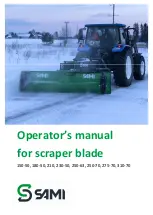
VER. 003_20.05.2011
OPERATION
PROGRAMMING OF RECEIVERS
BATTERY CHANGE
The device can operate in two modes: 1. Motion sensor, 2. Motion sensor with twilight switch. Operation modes are adjusted by
means of two switches which are under the top cover of the sensor. Mode 1 - adjust the switch to „C” position, Mode 2 - adjust the
switch to „F” position.
It is important to adjust the switches in the same position, otherwise they operate incorrectly.
In the
operation mode with a twilight sensor adjust luminous density by means of a potentiometer. Potentiometer adjustment to „ ” sign
means operation adjustment during daylight - about 20 lx, and potentiometer adjustment to „ ” sign means operation adjustment
during night - about 2 lx. Radio transmission range (up to 200 m - depending on a receiver) can be increased by means of a re-
transmitter or few RTN-01 retransmitters.
Battery discharge status is signalled by several LED red diode flashes during transmission time.
1. Remove the upper cover of the transmitter.
2. Remove the upper printed-circuit board.
3. Remove the batteries.
4. Mount new batteries.
Watch
battery polarisation marked
on the latch. Wrong battery
mounting may cause device
damage.
5. Mount the upper printed-circuit
board inserting the pins into the
connectors.
6. Mount the upper cover’s latches
into the latches of the base.
COOPERATION AND OPERATING RANGE
Symbol
ROP-01 ROP-02 ROB-01 SRP-02 SRP-03 RWG-01 RWL-01 ROM-01 ROM-10 RDP-01 RTN-01
RNK-02
180 m
200 m
200 m
200 m
200 m
250 m
180 m
250 m
250 m
180 m
250 m
RNK-04
180 m
200 m
200 m
200 m
200 m
250 m
180 m
250 m
250 m
180 m
250 m
P-256/8
230 m
250 m
250 m
250 m
250 m
300 m
200 m
300 m
300 m
230 m
300 m
P-257/4 (2)
180 m
200 m
200 m
200 m
200 m
250 m
180 m
250 m
250 m
180 m
250 m
RNM-10
230 m
250 m
250 m
250 m
250 m
300 m
200 m
300 m
300 m
230 m
300 m
RNP-01
160 m
180 m
180 m
180 m
180 m
200 m
160 m
200 m
200 m
160 m
200 m
RNP-02
160 m
180 m
180 m
180 m
180 m
200 m
160 m
200 m
200 m
160 m
200 m
RNL-01
160 m
180 m
180 m
lack*
lack*
200 m
160 m
200 m
200 m
160 m
200 m
RTN-01
200 m
200 m
200 m
200 m
200 m
250 m
200 m
250 m
250 m
200 m
250 m
RCR-01
160 m
180 m
180 m
lack*
lack*
200 m
160 m
200 m
200 m
160 m
200 m
RTI-01
160 m
180 m
180 m
180 m
180 m
200 m
160 m
200 m
200 m
160 m
200 m
RXM-01
230 m
250 m
250 m
250 m
250 m
300 m
200 m
300 m
300 m
230 m
300 m
* - 1-channel transmitters do not cooperate with roller blind controllers.
CAUTION: The given range concerns open area - an ideal condition without any natural or artificial obstacles. If there are some obstacles between a transmitter and a receiver,
it is advisable to decrease the range according to: wood and plaster: from 5 to 20 %, bricks: from 10 to 40 %, reinforced concrete: from 40 to 80 %,
metal: from 90 to 100%, glass: from 10 to 20 %, Over- and underground medium and high electrical power lines, radio and television transmitters,
GSM transmitters set close to a device system have also a negative influence on the range.
TRANSMITTERS
RECEIVERS
RNK-02
2–channel
button radio
transmitter
RNL-01
Radio foot
transmitter
ROP-01
1-channel
radio receiver
RWL-01
Radio
lighting switch
RNK-04
4-channel
button radio
transmitter
RTI-01
IR/EXTA FREE
transceiver
ROP-02
2-channel
radio receiver
RWG-01
Remote
control
socket
P-256/8
8-channel
remote controller
RNM-10
4-channel
radio modular
transmitter
RDP-01
1-channel
radio dimmer
SRP-02
Radio roller
blinds controller
P-257/4
4-channel
remote controller
RNP-01
4-channel
radio
transmitter
ROB-01/12-24V
Radio
gate controller
SRP-03
Central
radio roller
blinds controller
P-257/2
2-channel
remote controller
RNP-02
4-channel
radio
transmitter
ROM-01
1-channel
radio modular
receiver
ROM-10
2-channel
radio modular
receiver
RCR-01
Radio
motion sensor
RXM-01
RS485/EXTA
FREE transceiver
ACCESSORIES
ANT-01
External
antenna
RTN-01
Retransmitter
WHEN THE RADIO SIGNALS GO THROUGH OBSTACLES THERE IS OPERATION RANGE DECREASE
bricks 10% to 40 %, wood and plaster 5% to 20 %, reinforced concrete 40% to 80 %, metal 90% to100%, glass 10% to 20%
Press PROG push-button
of RCR-01, next release
the push-button. LED red diode
switches on under the lens
(constant signal).
Press PROG push-button
of RCR-01device, next
release the push-button.
LED red diode switches
on under the lens
(constant signal).
Press PROG
push-button
of RCR-01
device again for
a longer time.
Press PROG push-button of RCR-01
device and then release it.
LED red diode in the receiver
switches on (signal pulsates), and then
switches off - THE SENSOR IS ADDED.
Wait until LED diode
in RCR-01 device switches off.
Release PROG push-
button of RCR-01 device.
LED red diode in the
receiver switches on
(first signal pulsates, next
the signal is constant).
Press PROG push-button
to adjust the receiver to
programming mode.
LED red diode in the
receiver switches on
(constant signal).
Press PROG push-
button to adjust
the receiver to the
programming mode.
LED red diode in the
receiver switches on
(constant signal).
Press PROG push-button
of RCR-01 device and then
release it. LED red diode in the
receiver switches on (first signal
pulsates, next the signal is constant).
Press PROG push-button of RCR-01 device
and then release it. LED red diode in the
receiver switches on (signal pulsates), and
then switches off - THE SENSOR IS ADDED.
Wait until LED diode in RCR-01
device switches off.
An exemplary programming procedure with the use of RWL-01 receiver.
The procedure for the rest of radio EXTA FREE transmitters is analogous.
Mode 1.
Motion sensor
(operation modes’ switches in C-C position)
In this mode the receiver should be programmed to operate in time mode; time should be adjusted to 15 seconds. When there is a movement
within detection area the device sends a signal to the receiver every 10 seconds. After a signal has been sent, adjusted time t is counted again.
CAUTION: After each pressing of a push-button in a sensor, there are 10 seconds to start the next programming step. After 10 seconds
LED diode switches off in the sensor and RCR-01 device starts usual operation (programming procedure must be started again.
Mode 2.
Motion sensor with twilight switch
(operation modes’ switches in F-F position).
In this mode the receiver should be programmed to operate in monostable mode. When there is a movement within detection area the
sensor sends a switch on signal to the receiver.
The sensor sends a switch off signal after 20 seconds from the moment of no movement in the detection area.





















